 If you’re after super-fast Wireless kit and don’t mind the possibility of buying/refreshing your kit this could well be for you, if not we thought it would be best to start this article with a warning. Although the new PreN RangeMAX NEXT kit looks nice, there is a caveat (ours).
If you’re after super-fast Wireless kit and don’t mind the possibility of buying/refreshing your kit this could well be for you, if not we thought it would be best to start this article with a warning. Although the new PreN RangeMAX NEXT kit looks nice, there is a caveat (ours).
“This equipment is based on an unratifed standard and it is unlikely to interoperate with other equipment from this vendor or any other vendor. When the final specifications are ratified this equipment is very unlikely to meet that standard so purchase at your peril”.
Of course Netgear are not going to say that, or any other vendor of so called preN equipment.
The background on standards
The current draft of the IEEE 802.11n standard (v1.0) which manufacturers are working to, failed to be ratified with over 5,000 objections. When 802.11g equipment was released the draft had progressed much further and even so there were only about 500 objections. This means that some changes will probably be only software modifications – that can be provided by Netgear at some point in the future, however there’s a good chance several will be changes at the radio level which will require new silicon (i.e. chipset modifications). The standard isn’t likely to be ratified for another year, and then silicon will appear in the year following.
Netgear are saying they are being driven by the market, and the market wants kit now as it can offer significant throughput increases over current equipment.
 RangeMax Next Wireless ADSL Modem Router – DG834N
RangeMax Next Wireless ADSL Modem Router – DG834N
This is an ADSL2+ router, with a 4 port Ethernet switch and wireless interface. The Ethernet switch supports 10 or 100Mb/s.
It works with the WN311B PCI card or the WN511B PC Card, however, there’s no USB adapter yet.
In theory, the system support 300Mb/s, though throughput is more likely to be around 120Mb/s which is generally good enough for streaming video and other high bandwidth applications.
The router has a firewall built in, supports WEP and WPA (wireless encryption standards), and various parental controls.
While with 802.11b/g networks the channel has to be selected, now the router takes care of this for you and selects channels based on what it can “hear”, which makes set-up much easier and should give the customer the best throughput available.
There’s also a cable version called the WNR834B which gives an extra Ethernet port and dispenses with the ADSL2+ modem.
Be sure not to have an existing wireless LAN using 802.11b/g in the vicinity as current preN equipment tends to splat all over it (which isn’t a good thing).
 RangeMax Next Wireless Routers – Gigabit Edition – WNR854T
RangeMax Next Wireless Routers – Gigabit Edition – WNR854T
This is similar to the WNR834B, except it supports 10/100 and 1000Mb/s Ethernet ports.
The WN511T is the matching PC Card which works with it.
Interoperability
Even Netgear admitted that the WN311B/WN511B shouldn’t be used with the WRN834B or the WN511T with the DG834N or WNR834B. That’s because they use different chipsets, and they don’t work well together. They will still work, but not using preN, they’ll fall back to using 802.11g (and MIMO).
If Netgear can’t get their own kit to interoperate, it’s going to be just as bad or worse with other vendors, so customers had better make sure they buy all their equipment from the same vendor.
Even Intel, who are wireless mad at the moment are not supporting preN, and won’t until the standard is ratified.
MIMO
Multiple in Multiple Out. That’s a techie way of saying steerable beams. preN equipment has multiple aerials in the access point (ADSL or cable router) which work out the best signal heard from a client, and then use that aerial combination to send the best signal back.
This theoretically gives much better coverage and throughput, as clients connecting don’t necessarily don’t interfere with each other, while the steerable beams means a better radio signal to the client.
MIMO technology is already available on various wireless kit, including Netgear’s RangeMAX range.
Other noticable announcements
There’s some new powerline equipment coming out. The consumer variant supports 14Mb/s over the house electrical wiring. The new 85Mb/s business variant will be released later on in the year.
Be sure to enable security on the units, or anyone in the street on the same power loop will be able snoop all your traffic!!!
Media is the buzz
Though only a prototype so far, Netgear’s DEVA unit is an HD streaming client, supporting pictures, video and High Definition video. It will support preN and probably have a HDMI connection to the TV.
It supports Windows Media Connect, so automatically picks up any Windows XP servers with content on them. Other streaming sources will be supported by launch.
Pricing
The preN routers will cost around £170 ($310, E250)and the cards around £120 ($220, E175), products should be available imminently.
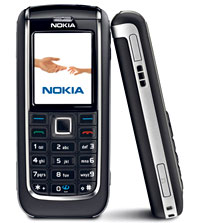 Slipping and slithering down the well oiled product slipway at Nokia is their latest swishy tri-band phone, the Nokia 6080 (no relation to their 1997 phone of the same name!).
Slipping and slithering down the well oiled product slipway at Nokia is their latest swishy tri-band phone, the Nokia 6080 (no relation to their 1997 phone of the same name!).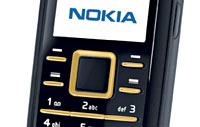 Sporting a backlit keypad and bright colour display, the handset comes bundled with a stereo headset and offers all the usual customisation options (with wallpapers, themes, annoying ring tones etc) to keep da kidz happy.
Sporting a backlit keypad and bright colour display, the handset comes bundled with a stereo headset and offers all the usual customisation options (with wallpapers, themes, annoying ring tones etc) to keep da kidz happy.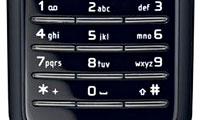 Talk time is a distinctively average 3.5 hours with a standby time of up to 12 days.
Talk time is a distinctively average 3.5 hours with a standby time of up to 12 days.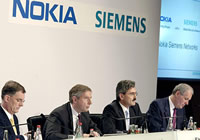 In the wake of the dot com boom, then the dot com collapse, equipment vendors have been feeling the fall-out and mergers seem to be the way to reconcile the collapsing markets. The Nokia-Siemens merger announcement bears witness to this.
In the wake of the dot com boom, then the dot com collapse, equipment vendors have been feeling the fall-out and mergers seem to be the way to reconcile the collapsing markets. The Nokia-Siemens merger announcement bears witness to this.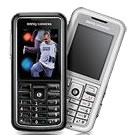 Siemens, a German giant
Siemens, a German giant Companies such as Huawei (“wu why” sometimes pronounced “who are we” which fits their appearance into markets that they had no presence in until recently) are starting to make serious dents into the Tier 1 telecoms/ISP markets.
Companies such as Huawei (“wu why” sometimes pronounced “who are we” which fits their appearance into markets that they had no presence in until recently) are starting to make serious dents into the Tier 1 telecoms/ISP markets.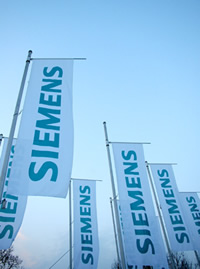 Now they’ve established themselves in the ISP market, the surrounding markets are being worked on (and since most ISPs are now owned by telecoms companies, it’s the telecoms markets that are easiest to move into).
Now they’ve established themselves in the ISP market, the surrounding markets are being worked on (and since most ISPs are now owned by telecoms companies, it’s the telecoms markets that are easiest to move into).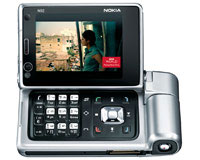 Nokia has announced a partnership with TeliaSonera Sweden to trial a complete DVB-H system, using Nokia’s Nordic know-how, their Mobile Broadcast System 3.0 and Nokia N92 mobile TV devices.
Nokia has announced a partnership with TeliaSonera Sweden to trial a complete DVB-H system, using Nokia’s Nordic know-how, their Mobile Broadcast System 3.0 and Nokia N92 mobile TV devices. “Nokia is very pleased to be working so closely with TeliaSonera Sweden in this new area of DVB-H based mobile TV. We believe strongly in the capability of this technology as well as in the mobile TV service, and we are looking forward to verify the full potential of mobile TV together with TeliaSonera Sweden,” purred Jan Lindgren, Vice President, Networks, Nokia.
“Nokia is very pleased to be working so closely with TeliaSonera Sweden in this new area of DVB-H based mobile TV. We believe strongly in the capability of this technology as well as in the mobile TV service, and we are looking forward to verify the full potential of mobile TV together with TeliaSonera Sweden,” purred Jan Lindgren, Vice President, Networks, Nokia.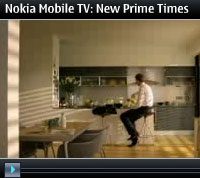 About the technology
About the technology LG Electronics has rolled up its beefy sleeves, raised its fists and shouted, “Come oooonnn!!!! Let’s be ‘aving you!” to the electronics world, declaring its intent to more than double its share of the world’s top products by 2010.
LG Electronics has rolled up its beefy sleeves, raised its fists and shouted, “Come oooonnn!!!! Let’s be ‘aving you!” to the electronics world, declaring its intent to more than double its share of the world’s top products by 2010.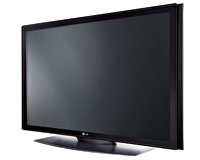 With a direct hit on the spittoon, he continued, “By substantially increasing the number of flagship goods through our technological prowess, we aim to evolve into a bona fide powerhouse.’
With a direct hit on the spittoon, he continued, “By substantially increasing the number of flagship goods through our technological prowess, we aim to evolve into a bona fide powerhouse.’ Pointing aggressively, Myung-wo says he wants the global market for plasma display panel (PDP) modules, PDP TVs, liquid crystal display (LCD) TVs, side-by-side refrigerators, built-in air conditioners and drum washers to be pwned by LG.
Pointing aggressively, Myung-wo says he wants the global market for plasma display panel (PDP) modules, PDP TVs, liquid crystal display (LCD) TVs, side-by-side refrigerators, built-in air conditioners and drum washers to be pwned by LG. Similarly, when it comes to domestic air conditioners, LG rules the roost, and the company is now wrestling for the crown of King of Flat-Panel Displays, knocking out 730,000 plasma units last year to nudge past market leaders Samsung SDI.
Similarly, when it comes to domestic air conditioners, LG rules the roost, and the company is now wrestling for the crown of King of Flat-Panel Displays, knocking out 730,000 plasma units last year to nudge past market leaders Samsung SDI.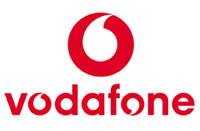 Vodafone Netherlands got in touch with us to tell us how wildly popular the World Cup has been on mobile phones on their service – breaking previous records of simultaneous viewers.
Vodafone Netherlands got in touch with us to tell us how wildly popular the World Cup has been on mobile phones on their service – breaking previous records of simultaneous viewers.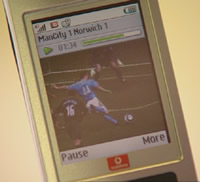 This would have been a big test for their mobile network, delivering something as bandwidth hungry as video all at the same time. Without any reports to us to the contrary, we can only assume it all went smoothly.
This would have been a big test for their mobile network, delivering something as bandwidth hungry as video all at the same time. Without any reports to us to the contrary, we can only assume it all went smoothly. Who’s in? Who’s out?
Who’s in? Who’s out? Much excitement is being generated by those companies already using Linux in their handsets. In a ‘don’t forget we’ve been doing this for ages’ way, Yoshiharu Tamura, Executive General Manager, Mobile Terminals Business Unit, NEC Corporation expounded , “As one of the leading pioneers with almost two years of experience shipping Linux-based mobile phones, we are delighted to participate in this initiative. We expect the foundation activities will accelerate further expansion of mobile Linux application developer participation, as well as global market growth of 3G mobile handsets.”
Much excitement is being generated by those companies already using Linux in their handsets. In a ‘don’t forget we’ve been doing this for ages’ way, Yoshiharu Tamura, Executive General Manager, Mobile Terminals Business Unit, NEC Corporation expounded , “As one of the leading pioneers with almost two years of experience shipping Linux-based mobile phones, we are delighted to participate in this initiative. We expect the foundation activities will accelerate further expansion of mobile Linux application developer participation, as well as global market growth of 3G mobile handsets.” The second billionth GSM mobile phone is expected to be connected this weekend according to the GSM Association (GSMA).
The second billionth GSM mobile phone is expected to be connected this weekend according to the GSM Association (GSMA). “While it took just 12 years for the industry to reach the first billion connections. The second billion has been achieved in just two and a half years boosted by the phenomenal take up of mobile in emerging markets such as China, India, Africa and Latin America, which accounted for 82% of the second billion subscribers,” he added, breathlessly.
“While it took just 12 years for the industry to reach the first billion connections. The second billion has been achieved in just two and a half years boosted by the phenomenal take up of mobile in emerging markets such as China, India, Africa and Latin America, which accounted for 82% of the second billion subscribers,” he added, breathlessly. The GSM Association continues to develop initiatives to help folks in the developing world gain access to mobile communications, developing a sub$30 low cost mobile phone and putting pressure on governments to remove tax barriers on mobile products and services.
The GSM Association continues to develop initiatives to help folks in the developing world gain access to mobile communications, developing a sub$30 low cost mobile phone and putting pressure on governments to remove tax barriers on mobile products and services.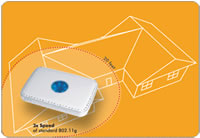 If you’re after super-fast Wireless kit and don’t mind the possibility of buying/refreshing your kit this could well be for you, if not we thought it would be best to start this article with a warning. Although the new PreN RangeMAX NEXT kit looks nice, there is a caveat (ours).
If you’re after super-fast Wireless kit and don’t mind the possibility of buying/refreshing your kit this could well be for you, if not we thought it would be best to start this article with a warning. Although the new PreN RangeMAX NEXT kit looks nice, there is a caveat (ours).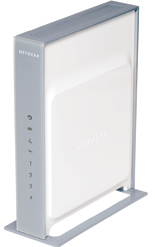 RangeMax Next Wireless ADSL Modem Router – DG834N
RangeMax Next Wireless ADSL Modem Router – DG834N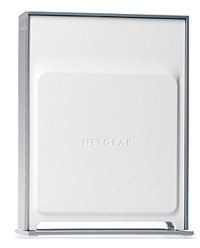 RangeMax Next Wireless Routers – Gigabit Edition – WNR854T
RangeMax Next Wireless Routers – Gigabit Edition – WNR854T LG has announced their new multimedia-tastic 12-inch notebook PC, the LW25 EXPRESS DUAL, which is, apparently, “a portable multimedia powerhouse.”
LG has announced their new multimedia-tastic 12-inch notebook PC, the LW25 EXPRESS DUAL, which is, apparently, “a portable multimedia powerhouse.” The built in optical drive (or Super Multi ODD as LG likes to call it) supports playback and recording of all existing optical media formats inluding dual-layer DVD burning, allowing you to cram up to 8.5GB data on a single DVD.
The built in optical drive (or Super Multi ODD as LG likes to call it) supports playback and recording of all existing optical media formats inluding dual-layer DVD burning, allowing you to cram up to 8.5GB data on a single DVD.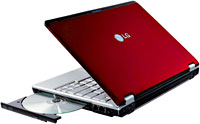 As for pricing and availability, your guess is as good as ours at the moment as LG seem to be keeping mum.
As for pricing and availability, your guess is as good as ours at the moment as LG seem to be keeping mum.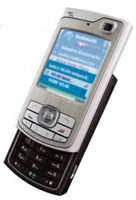 The dream of effortless – and easy to see – mobile Web surfing has taken a step forward with the release of Nokia’s N80 smartphone. The new device is rapidly garnering praise for its stunning screen which takes the stress out of Web browsing and picture viewing.
The dream of effortless – and easy to see – mobile Web surfing has taken a step forward with the release of Nokia’s N80 smartphone. The new device is rapidly garnering praise for its stunning screen which takes the stress out of Web browsing and picture viewing.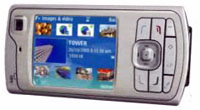 The increased density of the display makes the interface more crisp and easier to read and Nokia have taken advantage of this by utilizing vector graphics to sharpen up icons and fonts, reducing the blockiness associated with lower resolution devices.
The increased density of the display makes the interface more crisp and easier to read and Nokia have taken advantage of this by utilizing vector graphics to sharpen up icons and fonts, reducing the blockiness associated with lower resolution devices.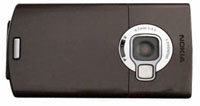 The N80 is pretty sharp on taking pictures too. With a 3.2 megapixel camera built-in, the N80 can deliver stills at 2048 x 1536 pixels, substantial enough to challenge regular digi cameras. Video recording is good at 352 x 288, the same resolution as the N70 and N90, and a VGA camera is mounted on the front for video calls.
The N80 is pretty sharp on taking pictures too. With a 3.2 megapixel camera built-in, the N80 can deliver stills at 2048 x 1536 pixels, substantial enough to challenge regular digi cameras. Video recording is good at 352 x 288, the same resolution as the N70 and N90, and a VGA camera is mounted on the front for video calls.